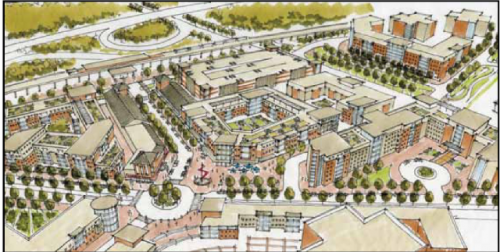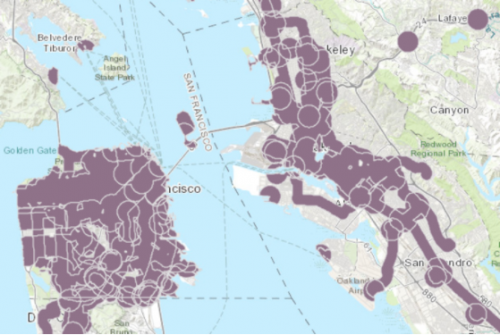It’s no secret that major cities across the United States – particularly the coastal gateway markets – are facing significant housing shortages for middle- and low-income residents. New York and California are facing the greatest challenges. Of the top 10 least affordable housing markets in the country, three are located in New York (Manhattan, Brooklyn, and Queens) and four are located in California (San Francisco, San Jose, Los Angeles, and San Diego).

Many urban policy experts (such as RXR EVP and former NYCEDC President Seth Pinsky) would argue that one way to improve affordability across the board would be to dramatically increase housing density at transit-oriented developments (“TODs”) in the suburbs. This additional housing supply within reasonable transit times would offer alternatives for regional residents and would impact the supply-demand relationship, particularly for middle income residents. To this end, lawmakers in both New York and California have recently proposed state-level legislation of TODs. Let’s take a look at why state-level controls may be necessary, as well as the specific proposals on the table in New York and California.
Combating Affordability Through State Controls
Land use in the United States has historically been delegated primarily to local jurisdictions based on the premise that local residents know what is best for their communities. But as with many urban issues, solutions to the affordable housing crisis face a major challenge in that most residents recognize the issue but are unwilling to make sacrifices necessary for change. Suburban residents are generally in favor of capital improvements to the regional public transportation infrastructure that will decrease their commuting times, but local NIMBY (“Not In My Back Yard”) movements have rejected new, high-density development around those transit stops that could have any real impact on the supply/demand equation and begin to impact affordability.
For this reason, many of these urban challenges – including affordable housing – must be approached on a regional basis to have a substantial impact. Some states are now taking it into their own hands to drive required regional changes that cannot be enacted at the local or even county levels in the larger metro areas. States have the benefit of direct access to federal budget allocations to fund major regional projects such as transportation infrastructure, while also avoiding some of the pressures of NIMBYism that could not be escaped by local government officials catering to their electorate.
California’s Senate Bill 827: State-Provided Density Bonuses for TODs
California Senate Bill 827 was proposed in January 2018 by State Senator Scott Wiener of San Francisco – California’s city with the greatest housing affordability issue. In what Slate refers to as an assault on “every assumption Americans have held about neighborhood politics and design for a century,” the bill proposes to eliminate local controls on residential development in “transit-rich” areas throughout the state. For the purposes of the bill, “transit-rich” areas are defined as being within one-half mile of a rail station or one-quarter mile of frequent bus routes. Within these zones, residential developers would not be subject to local restrictions on building height, density, restrictive design regulations, or parking requirements.

The benefits of the bill are rather obvious: a likely influx of a significant number of new residential units to meet increasing demand, and decreased local control leading to quicker development timelines. Digging deeper, we can also find some personal motivations for Senator Wiener. Wiener’s electorate is located in one of the least restrictive jurisdictions in the state when it comes to development density, meaning little change would come to the development process in the city of San Francisco. However, more restrictive jurisdictions would see dramatic change. In a relatively “transit-rich” metro area like the Bay Area, nearly all communities served by public transportation are considered “transit-rich” under the bill’s definition. Thus, it would appear that the majority of the Bay Area would lose their local land use controls, at least when it comes to residential development.
Senate Bill 827 has not yet reached the floor of the Senate for vote, but will serve as a telling example how the population’s outlook regarding local development controls may be changing.
Gov. Cuomo’s Proposed Congestion Tax and Value Capture Plan to Fund New York TODs
Meanwhile in New York, Governor Andrew Cuomo has proposed two new taxes at the state level to help fund transit infrastructure development in the state and specifically targeting the New York City metro area. As part of his state budget plan outlined in January 2018, Cuomo proposed a new “congestion pricing system” (read: tolls) as well as a “value-capture plan” (read: property tax) that would be used to fund public infrastructure investments.
Cuomo’s proposals are still fluid in terms of the specifics of the deals. However, the basic idea is to create new tolls geared toward reducing vehicular traffic in the most heavily congested parts of the city, while at the same time imposing a new property tax on landowners benefitting from the construction of new public transit stations (subway, rail, etc.) exceeding $100 million in cost. These taxes would foot the bill for the infrastructure investments themselves, as well as delivering 25% of the new property tax to the local municipalities impacted in order to provide funding for increased community services such as schools and police that would be necessary with new development.
Where Cuomo’s proposal may fall apart is exactly where the California Senate Bill excels. In New York, property owners impacted by the increased taxes from Cuomo’s value-capture plan would still need to work through local opposition to higher-density development in order to benefit significantly from transit improvements. Further, local businessowners could see a significant increase in rent for retail and office spaces as landlords seek to recoup property taxes from their tenants.
——————————————————————————————-
As urban challenges such as housing affordability continue to grow, new approaches such as state-level regulation will continue to be proposed as solutions. While the outcomes will vary from case to case, there is little question that these changes will spark debate over the merits of local versus regional or state controls over land use.
What role do you think the locality and the state should play in land use regulation?
